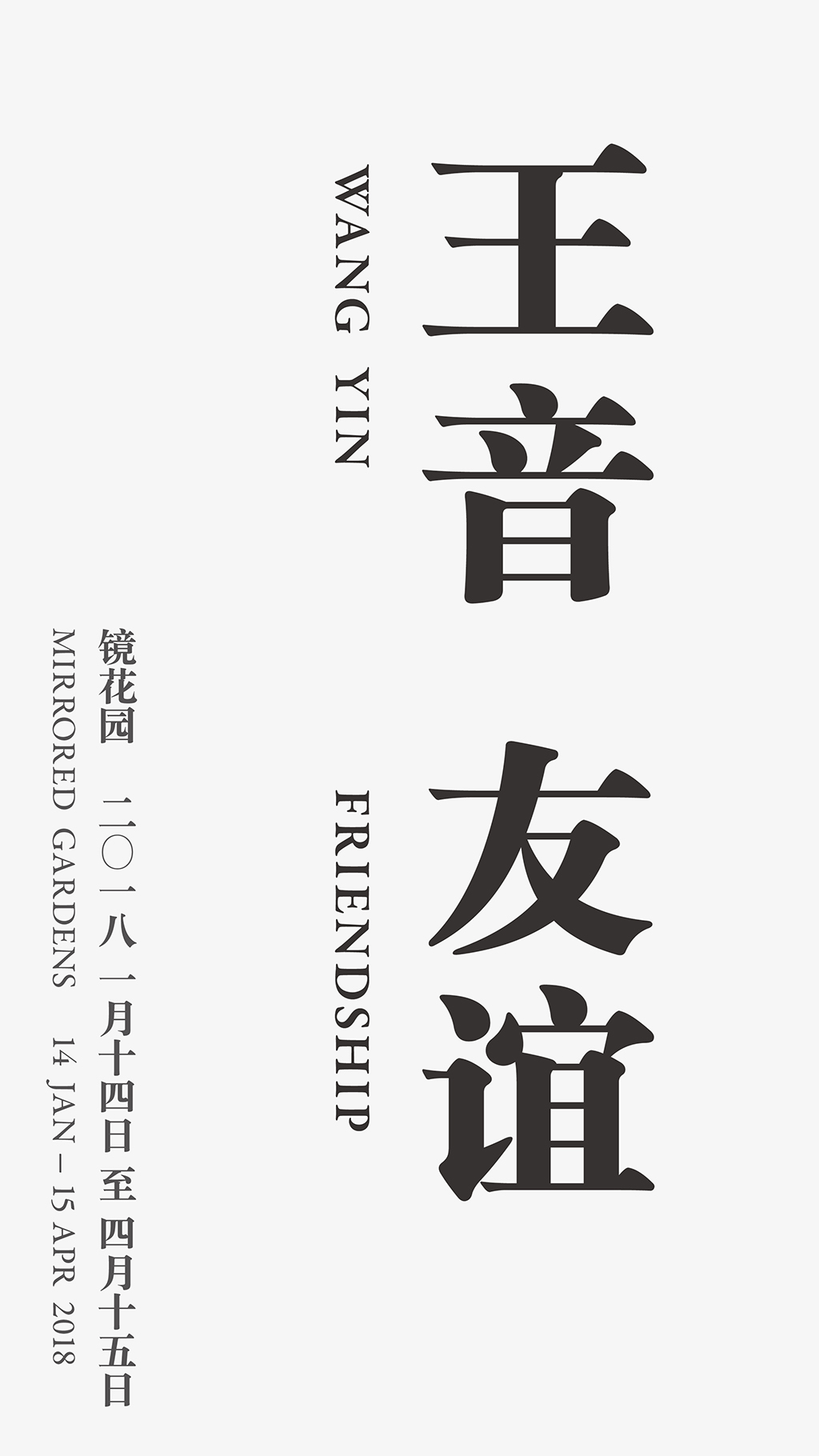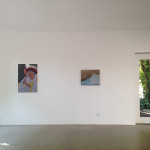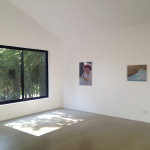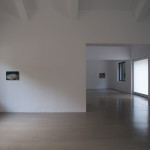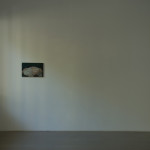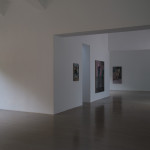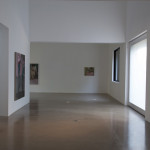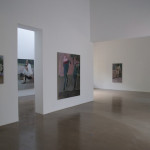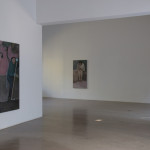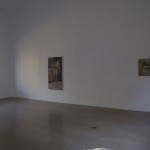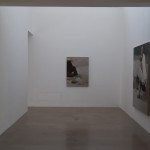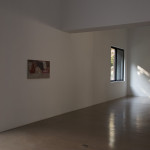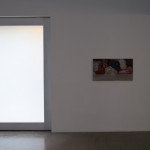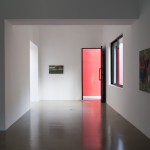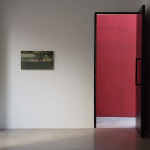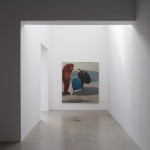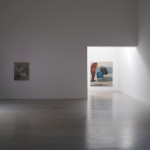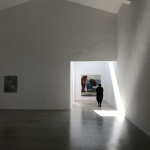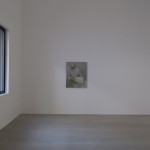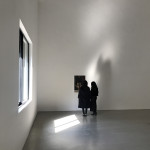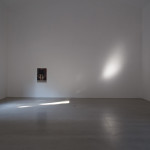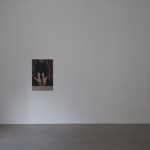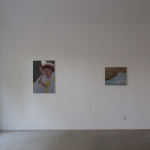In Wang Yin’s solo exhibition titled Friendship, paintings find their own place within the exhibition space following the rules of natural light during the day. These paintings aren’t subordinate to specific themes, nor are they builders of narratives within the space. They emerge and vanish with the natural light beginning and ending a day. Light provides the fundamental condition of seeing, it is an important element of physical space as well as a reflection of inner mental space. The diffused light dilutes the concentration of meaning, and further disperse and unfold the moments in which we’re situated.
Dusk
Allow me to leave behind the avenue, turn into the dim back alley, softly push open the half-shut and slightly battered door, enter the now long-abandoned home and walk into the dark room. Sweeping aside those broken months and years, those dust-coated ambitions and unfinished blueprints, I may not find the secret I imagine, but I will witness another person’s life—even if he is already long gone.
At another moment, seeing the city come back to life in the frigid air of the dawn hour, headlights in the fog flickering this way and that in the directions their cars were headed, I had the illusion of “being alive,” as if I had unconsciously glimpsed a group of people in deep sleep, who dreamed in their dreams the same world as mine.
It is as though there is a kind of waiting in Wang Yin’s paintings: waiting for the arrival of this ordinary moment—a moment that is not necessarily recognized by the people who live it; waiting for the arrival of a moment that simultaneously affects painting, painter and viewer all at once. Accordingly, we can enter time, and although the place is unclear, the objective unspecified, it by no means hinders the possibility of viscerally connecting with another moment: the moment we once shared together.
Wang Yin’s paintings escape “painting” by manifesting an even more sensible “appearance.”[1] Bathed in an even, unadorned light, their figures and places exist in a loose, unfocused, somewhat “rough” state (formed by brushwork that outwardly resembles drybrush technique but retains an inherent warmth)—their existence invites us to speak; they guide, but without pointing in any direction; perceive, yet without assuming the self-evidence of truth; depict, or inscribe, while merging with the subject.
Being immersed in, wandering among these “appearances,” it is as though we are enveloped in an atmosphere that allows us to experience the proper conditions for life. Just as “appearances” are never true, yet contain truth, the subjects of Wang Yin’s paintings are always anonymous people, anonymous things, anonymous places. Every “picture” has its source in reality, is an aspect of the relationship that arises between the artist and real space-time, but the transformation of the picture into an “appearance” is in fact the bodily experience of the artist’s long-term confrontation with a more abstract space-time, and its passing. As such, painting is itself the “necessary response” for the here and now, and so the “appearance” casts off excessive individual intent, allowing the world to emerge. It is not hard to appreciate why there should be a sense of natural self-containment in Wang Yin’s paintings, which gives viewers the impression of being generous and liberated.
At a certain moment, when I turn back to a certain scene in Wang Yin’s painting: the ambiguous silhouettes and poses, the indistinct places, the undefined actions and precisely this lucid but indeterminate atmosphere trigger my attachment to and permeation through other moments, as though it were this dim, diffuse light alone that releases us from the over-articulated objects of the surrounding epochs to approach the other tones of color found in the bottommost layers of time. The historical Chinese painters were all well aware of just what kind of lighting would allow the spread of this color, and the light in their paintings was not external to the representation of matter, but was instead a dense aura that emanated from matter, such that “form” became “appearance” under the influence of “awareness.”
This is the light of dawn, the light of noon, the light at dusk when day changes to night and work nears an end, fatigue nears relief. This is when even the gesture of eternal parting is suspended in mid-air. When the organization of society collapses, and history’s promises remain unrealized, people stand facing the light in silence, and another day begins without expectations.
(Essay by Hu Fang)
[1] The word used here in the Chinese, 象, has multiple connotations including “form,” “image,” “semblance,” and “sign.” It is a key concept in the classic treatises on divination, namely, the Yi Jing (Book of Changes); at the same time, it is also used in Chinese philosophy and poetry to reflect the relationship between linguistic expression and natural entities.
[ About the Artist ] >>
“Wang Yin: Friendship.” Guangzhou: The Pavilion, 2018.
- “Wang Yin: Friendship”, exhibition views at Mirrored Gardens, Guangzhou, 2018. Photography: Wen Peng. Courtesy of the Artist and Vitamin Creative Space. © Vitamin, 2018. All works of art by Wang Yin ©the Artist, 2018.
- “Wang Yin: Friendship”, exhibition views at Mirrored Gardens, Guangzhou, 2018. Photography: Wen Peng. Courtesy of the Artist and Vitamin Creative Space. © Vitamin, 2018. All works of art by Wang Yin ©the Artist, 2018.
- “Wang Yin: Friendship”, exhibition views at Mirrored Gardens, Guangzhou, 2018. Photography: Wen Peng. Courtesy of the Artist and Vitamin Creative Space. © Vitamin, 2018. All works of art by Wang Yin ©the Artist, 2018.
- “Wang Yin: Friendship”, exhibition views at Mirrored Gardens, Guangzhou, 2018. Photography: Wen Peng. Courtesy of the Artist and Vitamin Creative Space. © Vitamin, 2018. All works of art by Wang Yin ©the Artist, 2018.
- “Wang Yin: Friendship”, exhibition views at Mirrored Gardens, Guangzhou, 2018. Photography: Wen Peng. Courtesy of the Artist and Vitamin Creative Space. © Vitamin, 2018. All works of art by Wang Yin ©the Artist, 2018.
- “Wang Yin: Friendship”, exhibition views at Mirrored Gardens, Guangzhou, 2018. Photography: Wen Peng. Courtesy of the Artist and Vitamin Creative Space. © Vitamin, 2018. All works of art by Wang Yin ©the Artist, 2018.
- “Wang Yin: Friendship”, exhibition views at Mirrored Gardens, Guangzhou, 2018. Photography: Wen Peng. Courtesy of the Artist and Vitamin Creative Space. © Vitamin, 2018. All works of art by Wang Yin ©the Artist, 2018.
- “Wang Yin: Friendship”, exhibition views at Mirrored Gardens, Guangzhou, 2018. Photography: Wen Peng. Courtesy of the Artist and Vitamin Creative Space. © Vitamin, 2018. All works of art by Wang Yin ©the Artist, 2018.
- “Wang Yin: Friendship”, exhibition views at Mirrored Gardens, Guangzhou, 2018. Photography: Wen Peng. Courtesy of the Artist and Vitamin Creative Space. © Vitamin, 2018. All works of art by Wang Yin ©the Artist, 2018.
- “Wang Yin: Friendship”, exhibition views at Mirrored Gardens, Guangzhou, 2018. Photography: Wen Peng. Courtesy of the Artist and Vitamin Creative Space. © Vitamin, 2018. All works of art by Wang Yin ©the Artist, 2018.
- “Wang Yin: Friendship”, exhibition views at Mirrored Gardens, Guangzhou, 2018. Photography: Wen Peng. Courtesy of the Artist and Vitamin Creative Space. © Vitamin, 2018. All works of art by Wang Yin ©the Artist, 2018.
- “Wang Yin: Friendship”, exhibition views at Mirrored Gardens, Guangzhou, 2018. Photography: Wen Peng. Courtesy of the Artist and Vitamin Creative Space. © Vitamin, 2018. All works of art by Wang Yin ©the Artist, 2018.
- “Wang Yin: Friendship”, exhibition views at Mirrored Gardens, Guangzhou, 2018. Photography: Wen Peng. Courtesy of the Artist and Vitamin Creative Space. © Vitamin, 2018. All works of art by Wang Yin ©the Artist, 2018.
- “Wang Yin: Friendship”, exhibition views at Mirrored Gardens, Guangzhou, 2018. Photography: Wen Peng. Courtesy of the Artist and Vitamin Creative Space. © Vitamin, 2018. All works of art by Wang Yin ©the Artist, 2018.
- “Wang Yin: Friendship”, exhibition views at Mirrored Gardens, Guangzhou, 2018. Photography: Wen Peng. Courtesy of the Artist and Vitamin Creative Space. © Vitamin, 2018. All works of art by Wang Yin ©the Artist, 2018.
- “Wang Yin: Friendship”, exhibition views at Mirrored Gardens, Guangzhou, 2018. Photography: Wen Peng. Courtesy of the Artist and Vitamin Creative Space. © Vitamin, 2018. All works of art by Wang Yin ©the Artist, 2018.
- “Wang Yin: Friendship”, exhibition views at Mirrored Gardens, Guangzhou, 2018. Photography: Wen Peng. Courtesy of the Artist and Vitamin Creative Space. © Vitamin, 2018. All works of art by Wang Yin ©the Artist, 2018.
- “Wang Yin: Friendship”, exhibition views at Mirrored Gardens, Guangzhou, 2018. Photography: Wen Peng. Courtesy of the Artist and Vitamin Creative Space. © Vitamin, 2018. All works of art by Wang Yin ©the Artist, 2018.
- “Wang Yin: Friendship”, exhibition views at Mirrored Gardens, Guangzhou, 2018. Photography: Wen Peng. Courtesy of the Artist and Vitamin Creative Space. © Vitamin, 2018. All works of art by Wang Yin ©the Artist, 2018.
- “Wang Yin: Friendship”, exhibition views at Mirrored Gardens, Guangzhou, 2018. Photography: Wen Peng. Courtesy of the Artist and Vitamin Creative Space. © Vitamin, 2018. All works of art by Wang Yin ©the Artist, 2018.
- “Wang Yin: Friendship”, exhibition views at Mirrored Gardens, Guangzhou, 2018. Photography: Wen Peng. Courtesy of the Artist and Vitamin Creative Space. © Vitamin, 2018. All works of art by Wang Yin ©the Artist, 2018.
- “Wang Yin: Friendship”, exhibition views at Mirrored Gardens, Guangzhou, 2018. Photography: Wen Peng. Courtesy of the Artist and Vitamin Creative Space. © Vitamin, 2018. All works of art by Wang Yin ©the Artist, 2018.
- “Wang Yin: Friendship”, exhibition views at Mirrored Gardens, Guangzhou, 2018. Photography: Wen Peng. Courtesy of the Artist and Vitamin Creative Space. © Vitamin, 2018. All works of art by Wang Yin ©the Artist, 2018.
“Wang Yin: Friendship”, exhibition views at Mirrored Gardens, Guangzhou, 2018.
Photography: Wen Peng.
Courtesy of the Artist and Vitamin Creative Space. © Vitamin, 2018.
All works of art by Wang Yin ©the Artist, 2018.
Wang Yin: Friendship
Public opening: 14 January (Sunday), 2018
Duration: 14 January – 15 April, 2018
Opening hours of exhibition: Wednesday to Sunday, 11am to 4pm
Venue: Mirrored Gardens
Opening hours of Mirrored Gardens: Wednesday to Sunday, 11am to 5pm
Kind Remind: The exhibition space is lit solely using natural light. Based on the natural condition of light and the observation of the best viewing conditions, the visitors are kindly reminded that the exhibition space will be closed at 4pm.
Address: Hualong Agriculture Grand View Garden, Panyu, Guangzhou, China
Contact: press@vitamincreativespace.com
